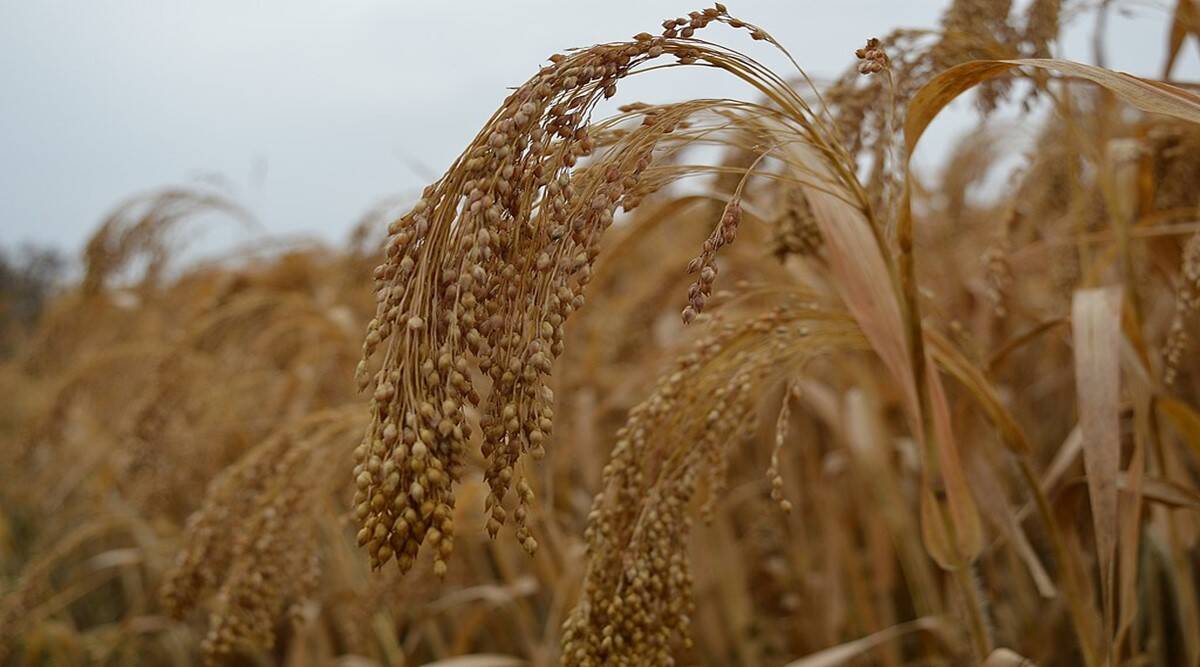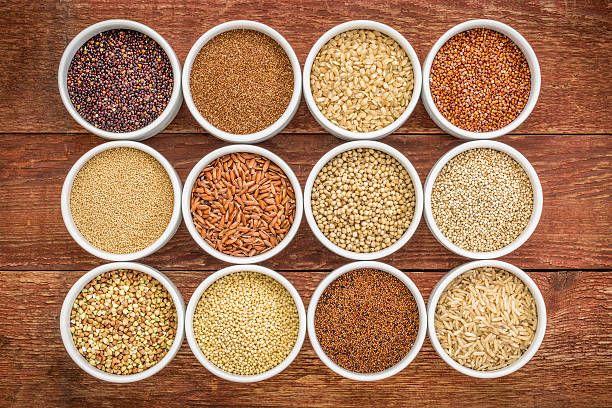Nutritious grain
Cereal food;Millet

Millet are cereal food belongs to the family of poaceae( grass family it is small, round and edible grain grown in India, Nigeria and other Asian and African countries and they are also known as coarse grains they played an important role in our daily diet during the 1960’s, nowadays its importance increasing because of its nutritional value.
Classification of millets
Nine types of millet cultivated in India such as sorghum, pearl millet, finger millet, fox tail millet, Barnyard millet, little millet, proso millet, kodo millet, and Brown top millet. Thus the classification done by depending upon their shape, size and colour.
Millet are classified in to major millet and minor millet by their area of production and size Hence sorghum, Pearl millet, Fox tail millet, Finger millet are major millet and others are minor millet. Finally they are classified in to naked grains and husked grains. Hence sorghum and pearl millet are naked millet therefore others are husked grains
Different name using in different languages
| Millet | Millet in Hindi | Millet in Gujarat | Millet in Tamil | Millet in Kannada | Millet in Telugu | Millet in Malayalam |
| Sorghum | Jowar | Jowari | Cholam | Jola | Jonna | Cholam |
| Pearl millet | Bajra | Bajri | Kambu | Sajje | Sajja | Kambam |
| Finger millet | Mandua | Nagli | Kelvargu | Ragi | Rangulu | Ragi |
| Little millet | Kutki | Gajro | Samai | Same | Samalu | Chama |
| Fox tail millet | Kangni | Kang | Tenai | Navane | Korra | Thina |
| Proso millet | Barri | Cheno | Panivaragu | Baragu | Varigu | Panivaragu |
| Kodomillet | Kodra | Kodra | varagu | Harka | Arikelu | Koovargu |
| Barnyard millet | Sanwa | Sama | Kuthiraivali | Oodalu | Udalu | Kavadapullu |
| Brown top millet | Hari Kangi | Harikong | palapul | Korale | Andakorra | Chama pothaval |
Millet farming and cultivation
In India millet are grown in kharif period Since the Kharif season starts in June and end in October. Hence the harvesting time between September and February, its height is from 1.8 to 4.5 in. and These tiny seeds mostly cultivated in semi-dry tropical regions of Asia and Africa.
In our country millet are mainly cultivated in Uttar pradesh, Punjab, Andhra Pradesh, Tamil Nadu, Rajasthan, Maharashtra and Gujarat. Thus they produce well on well-drained loamy soils.
Nutritional value of millet
In fact they are rich in nutrition and dietary fibre .The millet contain 7-12% protein, 2-5% fat, 65-75% Carbohydrates and 15-20% dietary fibre.
Its popularity increased because it’s gluten-free, high protein, fibre and antioxidants content. In fact millet provides phosphorus and magnesium.
Millet contain soluble fibre hence Proso millet contains the highest amount of protein 12.5% and these tiny seeds having a significant amount of carbohydrates and fatty acids.
Kodo millet exhibits the highest phenol content and proso millet the least whereas millet studies state that millet acts detoxifying agent, immune modulators and many other forms.
Millet can work as shield from Immune medicated enteropathic disease called Celiac and also it is gluten free hence it can decrease celiac diseases.
Health benefits of millet
Blood sugar and cholesterol control, Reduce the risk of cancer, Prevention of cardiovascular disease, Good source of Antioxidants, Aids in sleep, Helps in weight loss, slowing down muscle degradation consequently relieving menstrual cramps
Millet are powerhouse of nutrition because it is good for our heart health so they can reduce coronary blockage
Moreover millet contain magnesium which can reduce blood pressure stroke and attacks.
Fibre content of the millet helps to eliminate disorders such as constipation,excess gas,cramping
In fact millet can reduce diseases like atherosclerosis they are rich in potassium so they can effectively work as a vasodilator.
Millet contains magnesium consequently it stimulating the level of insulin which helps in balancing sugar level
They contains high amount of starch and protein because consumption of millet is good for babies,pregnant women and aged people
They are loaded with the components such as cur cumin, ellagic acid, quercetin which further helps in removing foreign agents and free radicals also balancing the enzymatic reaction in the body
India is the largest producer of many kinds of millet more importantly they carrying so many nutritional products. Because they are considered as “nutria-cereals”
Small millet can be grown in poor soil and irregular climate moreover millet can store in an ordinary condition for many days. Because of the storing ability farmers called them “famine reserves”
Daily consumption of millet not only gives more energy but also gives good health. Moreover millet are safeguard for our children from cancer inducing pesticides. Furthermore they can prevent premature ageing and boost our immune system.

Types of millet grown in India
FINGER MILLET
Eleusine coracana or finger millet is also known as raggi in India. Hence finger millet contains 5.8% protein, 1-2% ether extractive, 65-75% carbohydrates, 15 20 % dietary fiber and 2.5-3.5% minerals. Also finger millet has the highest amount of calcium (344mg %) and potassium (408mg %) in various region of India and Africa. It is rich in amino acids, non glutinous, and also it is a non acid forming grain easy to digest. Finger millet is rich in nutritional content so raggi is recommended a weaning food.
Health benefits
- Good for gluten allergy
- Helps to bone strengthening
- Finger millet is also good for ageing and metabolic diseases.
- Control your blood sugar level in diabetes, good source of natural iron
- Control Anemia diseases, blood pressure, liver disorder, asthma, heart attacks, malnutrition, degenerative diseases
BAJRA
Bajra is a type of pearl millet it is the edible seed of pearl millet and also grows in various regions. They are available in different shades white, yellow, Gray, brown, bluish people. Hence bajra contains carbohydrates 66.8%, sugars 0g, fiber 8.7g, protein 11.92g. It is a good rich source of nutrients and high in fiber, essential amino acids, and also a good resistant to drought, heat and some forms of contaminations.
Health benefits
- Helps to prevent chronic conditions
- Reduce risk of cardiovascular diseases
- prevent inflammatory diseases and, breast cancer, childhood asthma
- Boost your energy level
- Regulate nervous system and creating new protein
FOXTAIL MILLET
Foxtail millet is the other name of Thina, Thina is highly nutritious grain because it is good in energy source. It is rich in fiber content and minerals and also enriched with vitamin B6 consequently it help to regulate the body nervous system. Hence foxtail millet is high in calcium content which is very important to our bone health. It contains vitamin D, consumption of foxtail millet in the form of sprouts helps to fight against diseases and also help to fight against diseases such as osteoporosis and reduce chance of fracture. Daily consumption of foxtail millet helps to increase protein, good fat, carbs and amazing dietary fiber content.
Health benefits
- Strengthen nervous system, bones
- Boost cardiac health
- Reduce the chance of diabetes
- Reduce fat
- Promotes digestion
- Builds immunity
KODO MILLET
Varagu is the other name of kodomillet also known as cow grass, rice grass, ditch millet or Indian crown grass. Mainly grown in up, Gujarat, Karnataka, parts of Tamil Nadu, parts of Maharashtra, Odessa, and west Bengal, Rajasthan, Uttar Pradesh and foot hills of Himalaya. It have high protein content(11%) low fat(4.2%) 65g of carbohydrates, B vitamins, niacin, B6 and 23.1g of folic acid and minerals such as calcium, iron, potassium, magnesium and zinc and also rich in antioxidants and polyphenols. Its antioxidant potential is much higher than any other millet and major cereals, phosphorous content is lower in kodomillet.
Health benefits
- Kodomillet is easy to digest
- Control body weight
- Good for postmenopausal women, good for cardiovascular diseases.
- Good for diabetic people
- Gluten free
- Reduce bad cholesterol
FLAX SEED
linum usitatissimum is the botanical name of flax seed. Thus they are full of proteins and helps to digestion. Not only lowering cholesterol but also manage some cancers. Likewise help to mange weight, improving insulin, reduce menopause diseases in women. Similarly in some circles flax seed grows well- drained sandy loam. Correspondingly nutritional fact of flax seed-calories 534, fat 42g, saturated fat 3.7g, cholesterol 0mg, sodium 30mg, potassium 813 mg, total carbohydrates 29g, sugar 1.6g . Flax seed loaded with nutrients and also contain omega a-3 fatty acids
Health benefits
- Helps to protect against cancer
- low cholesterol levels
- Control the risk of heart attacks, obesity, diabetes and metabolic syndrome.
- improve digestion
- protects against breast cancer and colon cancer
- Inhibit tumor
- reduce inflammation and illness
BARNYARD MILLET
Echinochloa esculenta is the botanical name of barnyard millet. Hence it is a wild seed not a grain mainly grown in hill areas of Uttaranchal and also it is superior to major and minor millet these are rich source of dietary fiber, iron, zinc, calcium, protein, magnesium, fat and some essential amino acids. Similarly kuthira vali is the Malayalam name of barnyard millet. Besides these are the small packets of nutrients contains iron, protein, fiber and a significant amount of calcium which strengthen your bones and teeth.
Health benefits
- good for diabetics
- rich in antioxidants
- helps to reduce blood cholesterol levels
- helps in relieve constipation
- strengthen immune system
- gluten free
LITTLE MILLET
Little Millet is the power house of nutrients and contains excellent antioxidant properties also it is mostly consumed like rice consumption. These are small grains which easy to cook whereas little millet is mostly cultivated in hill areas. Botanical name of little millet is panicum sumatrense, is a species of millet in the family poaceae as for nutritional value, it is the real health bomb it is rich in protein and fiber. It contain as much as 9.7 grams of protein and 7.6 grams of fiber per 100gHowever, it also contains 60.9g of carbohydrates per 100g.It provides the following nutrients per 100g calories 329Kcal, protein 9.7g, fat 5.2g, ash 5.4g, fiber 7.6g, carbohydrates 60.9g, calcium 17mg, iron 9.3mg, Thiamine 0.30mg, Riboflavin 0.09mg, Niacin 3.2mgResearch finds that edible forms of small millet are rich in antioxidants such as Tocopherols, Tocotrienols and carotenoids.
Health benefits
- good for pregnant women’s and babies
- helps to prevent blood sugar consequently it help to reduce diabetes
- work as antioxidant in your body
- good for combat lifestyle diseases
- prevent premature ageing and metabolic diseases
WHITE SORGHUM
White sorghum is a feed ingredient for poultry, but is also a food grade product found in flour,totillas, chips, popped variety(caramel covered) and is used mostly to either blend with wheat or a substitute for wheat flour for those allergic to the gluten found in wheat. Sorghum grain contains 632 calories per 192g serving. Moreover this serving contains 6.6g of fat, 20g of protein and 138g of dietary fiber the rest is complex carbohydrates.
Health benefits
- sorghum is gluten free
- sorghum is rich in fiber
- great food for diabetics
- source of protein
- packed with essential minerals
- helps you lose weight
- preserve the health of your digestive system
Refence https://en.wikipedia.org/wiki/Millet
little millet https://www.hithayush.com/product/little-millet-500g/
flax seed https://www.hithayush.com/product/flax-seed-200g
white sorghum https://www.hithayush.com/product/white-sorghum-500g/
fox tail millet https://www.hithayush.com/product/foxtail-millet-500g/
njavra rice https://www.hithayush.com/product/njvara-rice-500g-www-hithayush-com/
